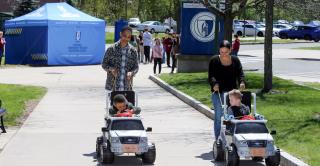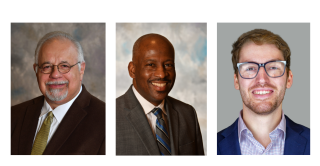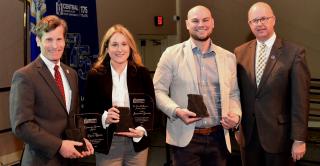
By Amy J. Barry
Spring is in the air. Here in Connecticut, like clockwork, flowers are blooming, trees are budding, and birds are busy building nests.
Naturally, we celebrate Earth Day in the spring, but a team at Central Connecticut State University aims to remind us all that our fragile planet needs protection all year round.
The President’s Advisory Council on Environmental Sustainability (PACES) was established in 2007 to bring together the campus community to advise the university president on the best ways to achieve environmental sustainability, including, but not limited to, a climate action plan.
“It was part of a push for universities and other entities to become responsible for reducing their carbon footprint,” explains Kelly Selby, coordinator of the Environmental Health and Safety department (EHS).
PACES took a hiatus during the pandemic while EHS was heavily involved in managing the COVID-19 response on campus and is now back in full force. Co-chaired by David Serino, director of EHS, the council casts a wide net to include up to 18 faculty, staff, and students appointed by President Toro.
“We were tasked with submitting briefs to President Toro in three areas,” Serino says. “Campus energy (submitted in 2019), recycling and waste reduction, our current focus; and visibility and education — next year’s objective.”
Campus-wide sustainability initiatives
New programs and partnerships are being implemented throughout campus to make all facilities more energy efficient and environmentally friendly.
The university has partnered with Eversource Energy through its Energize CT initiative to track how energy is being used and increase efficiency. Through this long-term program, Eversource Energy and Avangrid provide free support to municipalities to develop and implement Strategic Energy Management programs.
“We will be meeting for what they call a ‘Treasure Hunt,’” Selby says. “We’ll break up into teams to give them access for the day to various building on campus — old and new — to get an idea where we can make improvements and develop a plan to implement them.”
PACES also plans to install a new fuel cell on campus. For over a decade, a 1.5 megawatt fuel cell has been offsetting the amount of electricity the university obtains from the Eversource utility grid.
“We are working with the Board of Regents to install a second cell to further lower the demand on our own Energy Center,” Serino explains. “It should be completed sometime in 2025.”
Over the next year, the university will install seven more Electric Vehicle charging stations on campus. Currently, Central offers 18 charging stations.
“We’ve had more demand from faculty and students and see more usage of our chargers from people who drive to campus,” Selby says. “They are now in every parking garage and more will be added for a total of 25 by Fall 2025.”
The university continues to construct all new buildings to high performance regulations and, in some cases, meet or exceed the Leadership in Energy and Environmental Design program’s silver rating for green buildings. Serino and Selby also note that Central uses LED fixtures — the most energy-efficient lighting available today — in new construction and is upgrading existing lighting to LED.
Meanwhile, food waste diversion services at dining facilities and single-stream recycling on campus are helping to reduce landfill waste.
Sustaining student enthusiasm
The student-run Sustainability Club launched in 2018 and has been very active over the past two years, according to Charles Button, professor of Geography and founder/chair of the Global Environmental Action Coalition.
“Kate Terrio, president of the club over the past three years, has done a lot of really good work regarding the three pillars of sustainability: environmental, social, and economic,” he says.
Selby adds, “We’re happy students are getting involved because they’re the ones that will take these initiatives with them for the rest of their lives, and what great skills to be learning here at CCSU where we can provide a place for them to have a voice.”
Club initiatives include a clothing swap in which donated clothing is gathered into a free thrift-shop-style pop-up store on campus, which provides a way for students to give and get repurposed clothing at no cost.
Selby and EHS also introduced the Devils Move-Out Donation Drive in 2018, and it is now a joint project with the Sustainability Club. The program collects unwanted items from dorm rooms and redirects them from landfills by redistributing them through local nonprofit organizations.
Global Environmental Sustainability Symposium
Held annually during the week of Earth Day, this year’s event will take place Thursday, April 25, in the Student Center. It is free and open to the public. Professor Button, who directs the symposium, describes how it has grown and changed over the years.
“It started out tied into a major national event that was all about climate change,” Button recalls. “We soon realized that this is about more than climate change but sustainability — the social and economic actions that are causing the problems. Our symposium has grown into the biggest in the nation.”
Button believes that the most significant change impacting the symposium is that climate change is now a regular part of the public discourse.
“The media has finally gotten it that climate change is not an opinion — that it’s science,” he says. “In the early years, we were asked why we didn’t have anyone presenting with the other ‘opinion.’ That hasn’t happened in the last 15 years.”
One of the regular highlights of the symposium for Button is the student poster presentations.
“I’m always pumped up about the poster sessions,” he says. “It’s a chance for students to shine. Particularly in the past five years where professors are having their students do posters in other fields of study. And beyond us, we have students from ECSU and UConn hopping onboard. We have over 50 posters this year.”
Button is also enthusiastic about how the humanities and arts are woven into the symposium to make the science of these issues more engaging and approachable for everyone.
This year’s symposium will include a “Recycling is Magic” interactive theatrical performance; a Sustainability Social Mixer jazz performance by Brown Paper Sax; and a panel discussion on communicating climate change through the Humanities. Panelists will include English professors who will illustrate how storytelling can help people understand and take actions to address climate change.
Learn more about the symposium at https://www.ccsu.edu/gesac/17th-annual-global-environmental-sustainabil….



